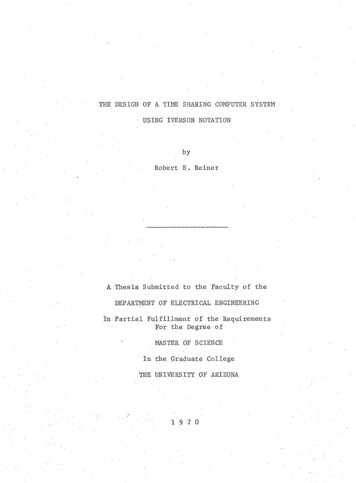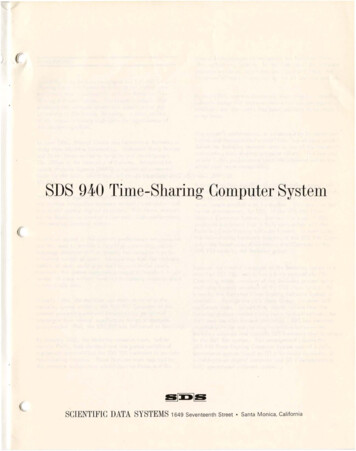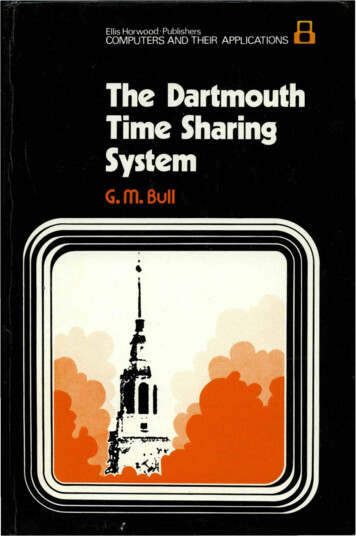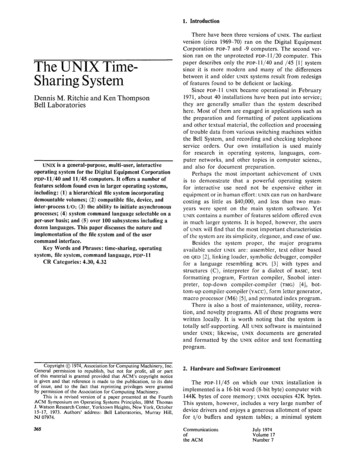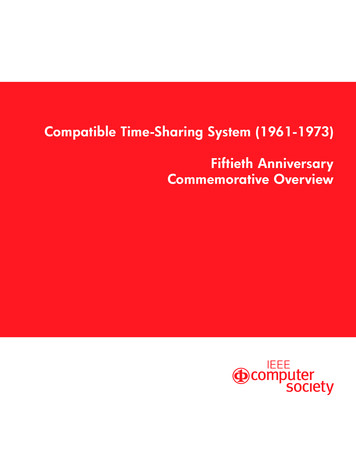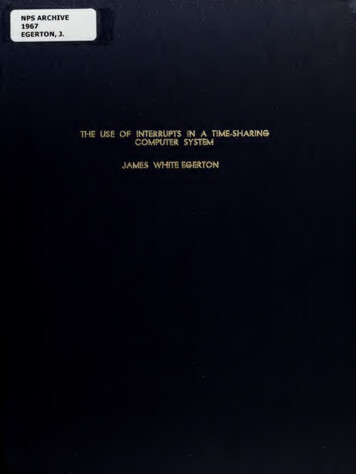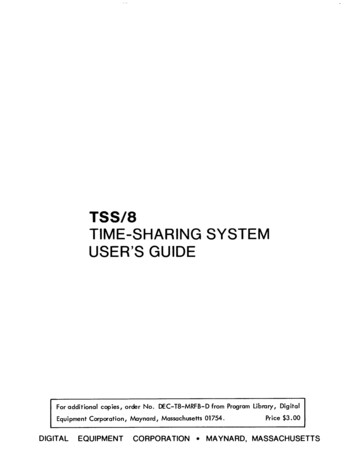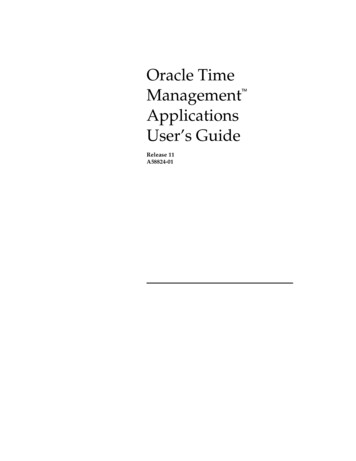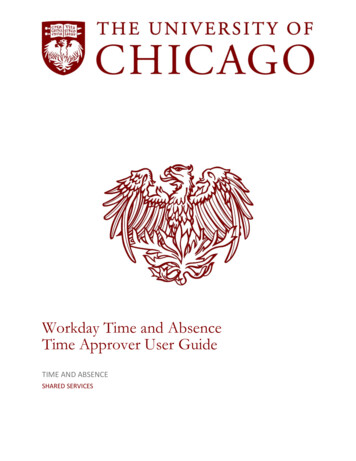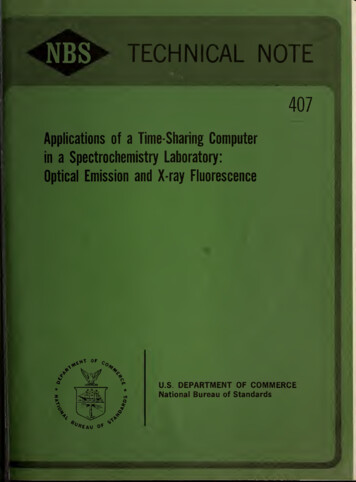
Transcription
LIMIPAIMmNBSIm.# mI407Applications of a Time-Sharing Computera Spectrochemistry Laboratory:inOptical Emission and X-ray FluorescenceA**»OF coA1*'"!'/»ZV)9o\ tAUOf *U.S.DEPARTMENT OF COMMERCENational Bureau of Standards
:THE NATIONAL BUREAU OF STANDARDSof Standards 1 provides measurement and technical information servicesessential to the efficiency and effectiveness of the work of the Nation's scientists and engineers. TheBureau serves also as a focal point in the Federal Government for assuring maximum application ofThe National Bureauthe physicalaccomplishand engineering sciences to the advancement of technology in industry and commerce. ToBureau is organized into three institutes covering broad program areas ofthis mission, theresearch and services:THE INSTITUTE FOR BASIC STANDARDS.provides the central basis within the Unitedand consistent system of physical measurements, coordinates that system with themeasurement systems of other nations, and furnishes essential services leading to accurate and uniformphysical measurements throughout the Nation's scientific community, industry, and commerce. ThisStates for a completeeach serving a classical subject matter area:Mathematics Electricity Metrology Mechanics Heat Atomic Physics PhysicalChemistry Radiation Physics- Laboratory Astrophysics 2 Radio Standards Laboratory, 2 whichincludes Radio Standards Physics and Radio Standards EngineeringOffice of Standard Refer-Institute comprises a series of ence Data.THE INSTITUTE FOR MATERIALS RESEARCHconducts materials research and provides.associated materials services including mainly reference materials and data on the properties of materials. Beyond its direct interest to the Nation's scientists and engineers, this Institute yields serviceswhich are essential to the advancement of technology in industry and commerce. This Institute is or.ganized primarily by technical fields:Analytical Chemistry MetallurgyReactor Radiationsogenics 2Office of Standard Reference Materials.————THE INSTITUTE FOR APPLIED TECHNOLOGY—Polymers—Inorganic Materials—Cry-provides technical services to promote theuse of available technology and to facilitate technological innovation in industry and government. Theprincipal elements of this Institute areBuilding Research Electronic Instrumentation Technical Analysis Center for Computer Sciences and Technology Textile and Apparel Technology Center Office of Weights and MeasuresOffice of Engineering Standards ServicesOffice of Invention and InnovationOffice of VehicleSystems Research Clearinghouse for Federal Scientific and Technical Information 3 MaterialsEvaluation LaboratoryNBS/GSA Testing Laboratory.——1——————Headquarters and Laboratoriesat Gaithersburg,3.————Maryland, unless otherwise noted: mailing address Washington, D. C,20234.2.Located at Boulder, Colorado, 80302.Located at 5285 Port Royal Road, Springfield, Virginia 22151.
UNITED STATES DEPARTMENT OF COMMERCEAlexander B. Trowbridge, SecretaryNATIONAL BUREAU OF STANDARDS A. V. Astin,DirectorTECHNICAL NOTE 407NBSISSUEDFEBRUARY1968Applications of a Time-SharinginComputera Spectrochemistry Laboratory:Optical Emissionand X-ray FluorescenceStanley D. Rasberry, Marvin Margoshes,and Bourdon F. ScribnerSpectrochemical Analysis SectionAnalytical Chemistry DivisionInstitute for Materials ResearchNBS Technical Notes are designed to supplement theBureau's regular publications program. They provide ameans for making available scientific data that are oftransient or limited interest. Technical Notes may belisted or referred to in the open literature.Forsaleby the Superintendent of Documents, Government Printing OfficeWashington, D.C., 20402 - Price 40 cents
TABLE OP ION1THE COMPUTER SYSTEM3THE PROGRAMMING LANGUAGE AND SYSTEM COMMANDS.THE INPUT STATEMENT713APPLICATIONS OF THE SYSTEM IN SPECTROCHEMISTRY.15LIMITATIONS OP THE pendixI.Appendix II.Basic Statements25Summary Description of Some ComputerPrograms in the BASIC Language ofInterest to Other SpectrochemistryLaboratoriesKAISERINTEN2CODEBC and CFIT2XRAY1XRAY2PLATE1PLATE2STATTEMPER and PROFILC0LS8WRITE1, WRITE2, WRITE4TIME26272931373941434547505153LIST OF FIGURESPAGEFIGURE NO.1.2.3.Block diagram of time-sharing computersystemTeletype terminal for communication withtime-sharing computerExample of use of the time-shared computersystemin3412
.:APPLICATIONS OF A TIME-SHARING COMPUTER IN ASPECTROCHEMISTRY LABORATORY:OPTICAL EMISSION AND X-RAY FLUORESCENCEStanleyD. Rasberry, Marvin Margoshes,and Bourdon F. ScribnerSpectrochemical Analysis SectionInstitute for Materials ResearchNational Bureau of StandardsWashington, D. C. 20234ABSTRACTAtime-sharing computer system employing the DartmouthCollege Basic compiler has been in use in this laboratoryfor more than two years,and it has been applied to bothroutine and non-routine calculations.Descriptions aregiven of the computer system and its associated programminglanguage and commands.Typical applications and advantagesand disadvantages of the system are discussed.An appendixcontains descriptions of 13 programs thought to be of interest to other optical and x-ray spectrochemistry laboratories.Examples of input and output are given with each of theseprogramsKey WordsAnalytical chemistry, calculations, computers, emissionspectroscopy, programming, spectrochemical analysis, timesharing computer, x-ray spectroscopy.iv
I.INTRODUCTIONThe application of computers to data reduction andhandling in spectrochemical analysis has been shown (see,for example, references [1],[2])to provide significantsavings in time and cost in certain situations.In addition,computer reduction of data may permit much more extensivecalculations to be made than are otherwise feasible. Thisincreased computation facility can give improved resultsand can even make analyses possible which would otherwisenot be done by spectrochemical methods.Until recently, a laboratory employing computers hada choicelimited to making use of a central computerlaboratory or installing a computer.The first optionoften involves delays of as long as several hours betweensubmission of data and receipt of the results; such delaysare most objectionable when the analyses form a part of acontrol loop and during research on computing methods.Thesecond option provides for extremely rapid processing ofdata, particularly when a spectrometer is attached directlyto a computer, but it requires a considerable capitalinvestment as well as maintenance costs.Specialized central computers provided with multipleremote terminals have become well known in the form ofreservation services such as those in use by airlines andhotel chains, military systems like SAGE, the New YorkStock Exchange quotation system, and systems in stores tohandle orders, billing, and stock control.General-purpose, remote-terminal system, are a more recentdevelopment (3, , 5, 6). With these systems, data can betransmitted and output can be received at a terminal inthe laboratory, thus saving the time normally required tocarry this information to and from the computer laboratory.
The information may be processed by the central computersystem onabatch basis, or the system may employ time-sharing or multiprocessing, either of which will give verynearly as fast processing of data as if the user had hisown computer.Several general-purpose, time-sharing systems are nowin operation.Some of these are owned by companies,universities, and government laboratories for the use oftheir own personnel.Other installations, called "computerutilities," are operated by computer manufacturers andservice bureaus, and make the remote-terminal serviceavailable to any user on a contract basis.This report describes more than two years'experiencewith a time-sharing system in a spectrochemical laboratory.The system and its programming language and operation aredescribed, examples are given of some applications, and theadvantages and disadvantages of the system for spectrochemical applications are summarized.descriptions ofaAn appendix containsnumber of programs which may be of use toother spectrochemical laboratories.The Spectrochemical Analysis Section has been makinguse of computers for data reduction since 1955, and in 1956it had installed thefirst digital spectrometer readoutproviding data in a form suitable for input to a computer.Until recently, computer applications in this laboratorywere restricted to the larger jobs, such as homogeneitytesting in the process of preparing standard referencematerials.With the availability of the time-sharingservice, computer use has been extended to many morecomputation tasks, as is described in this report.
—II.Figure1THE COMPUTER SYSTEMis a block diagram of the computer systemdiscussed in this report.The system and software (5)were developed at Dartmouth College by a group headed byProfessors JohnG.Kemeny and Thomas E. Kurtz.It makesuse of two computers, a master and a slave, a large diskmemory, a number of remote terminals, up to HO of whichcan be served by the system simultaneously, and auxiliaryinput-output devices and magnetic tape memory, allcommercially available equipment. The remote terminalsmay be at any location that can be reached by goodquality telephone Y)Figure1.Block diagram of time-sharing computer system.The functions of the master computer are communicationwith the terminals and control of the system.The calculations are done on the central processor unit (slave computer),and the disk memory serves for temporary and permanent storage of programs, data, and other information.The contentsof the disk memory are copied daily onto a magnetic tape;if the disk memory fails, it can be reloaded with infor-mation no more than one day old.The auxiliary input-outputdevices are used for initial loading of the disk, and forbatch operation of the computer at night or during periodsof light use of the time-sharing system.
Figureshows the remote terminal in this laboratory;2standard teletypewriter (Teletype Model 33ASR) whichPrograms oris rented from the local telephone company.data may be entered on the keyboard or from a punched paperit isatape which is fed into the tape reader.The punched papertapes may have been prepared in advance on the same teletypewriter, or they can be prepared automatically by suitablereadout equipment on instruments in the laboratory.Figure2.Teletype terminal for communicationwith time-sharing computer.Information sent from the terminal to the mastercomputer is stored on the disk memory. When the operatorhas transmitted all necessary information to the computer,he types the command RUN.His program and data are thenplaced in a queue for time on the central processor.Each user who has typed RUN is allotted a few seconds oftime on the central processor.If this allotment of timeis not enough to finish the calculations,the partiallycomplete program is stored on the disk memory while otherusers are given their turns, and it is then reentered intothe slave computer.This process is repeated as often as is
necessary to complete the calculations.The average pro-gram requires less than 10 seconds of computing time and iscompleted by the computer In less than a minute, althoughrequired for transmission of the results, depending on the length of the output.a longer time may beThe results of the calculations are also stored on thedisk memory, and they are then picked up by the mastercomputer and transmitted to the terminal.Printout startsas soon as a part of the results is available,so that theoperator may well have received the first printout beforethe calculations are complete.This makes it possiblefor the operator to intervene in the calculations, as willbe described below.With up to 40 users in contact with the system it mightseem that any one user must wait for a considerable timefor a calculation to be entered into the slave computer.In practice, much more time is spent by each user inentering information or receiving output than is requiredfor the calculations.Thus, only a few users requirecalculations on the slave computer at any one time, andthe overall effect is to give each user nearly as rapidresponse as if he had his own computer.Programs need not be transmitted each time they are tobe used.Each program is assigned a name by the user, andwhen it has been entered the first time the command SAVEwill cause the program to be stored permanently on the diskmemory.When the program is to be used again, it can beMaterialcalled up by a simple sequence of commands.stored on the disk can be removed by the command UNSAVE.program can be modified; the changes will not bestored permanently unless the command SAVE is typed afterchanges are made.Thus, the user can try various modifi-A storedcations without hazard to the stored program.
Saved programs are stored on the disk memory in theBASIC language (see below) and are converted to binary machine language (compiled) each time they are run.The bi-nary form of the program is stored temporarily on the diskmemory each time an incompletely processed program is movedout of the slave computer to permit another user a turn.Conversion of the program from BASIC to machine language oneach run makes possible frequent changes of the program.The BASIC compiler in the system is efficient enough sothat even the longest program is compiled within a fewseconds, and the delay is hardly seen by the user.
III.THE PROGRAMMING LANGUAGE AND SYSTEM COMMANDSOne difficulty in the routine application of computershas been the need for detailed instructions, or programs,in binary form for the computer.In order to simplifyprogramming, a number of languages have been developed sothat the instructions can be written in letters and decimalnumbers, usually in a form resembling algebraic expressionswith the alphabet
ApplicationsofaTime-SharingComputer inaSpectrochemistryLaboratory: OpticalEmissionandX-rayFluorescence StanleyD.Rasberry,MarvinMargoshes, andBourdonF.Scribner SpectrochemicalAnalysisSection AnalyticalChemistryDivision InstituteforMaterialsResearch NBSTechnicalNotesaredesignedtosupplementthe Bureau'sregularpublicationsprogram.Theyprovidea
